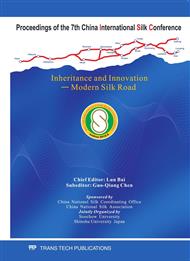p.439
p.445
p.450
p.454
p.460
p.465
p.469
p.474
p.480
Development of Electronic Real-Time Inspecting System for Raw Silk Based on FPGA
Abstract:
Traditional seriplane testing method has been used to detect the evenness and defects of raw silk for a long time, the results of which are affected subjectively by the examiner to a certain extent and are controversial. In this paper, improved based on SD-1 size tester of raw silk, built-in FPGA chip and 9004 real-time controller and winding machine are used to develop a fast real-time inspecting system for evenness, cleanness and neatness of raw silk. This can resolve the problems of the independent intellectual property rights of sensors and process software troubling electronic inspection of raw silk, and realize the conversion, acquisition, real-time differentiation, results display and storage of continuous dynamic voltage signal of raw silk. Compared with the same type device, this system has a higher processing efficiency and better results objectivity.
Info:
Periodical:
Pages:
460-464
Citation:
Online since:
January 2011
Authors:
Price:
Сopyright:
© 2011 Trans Tech Publications Ltd. All Rights Reserved
Share:
Citation:


